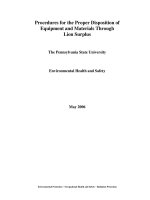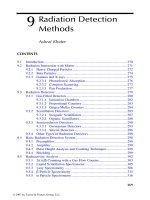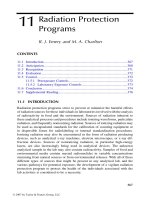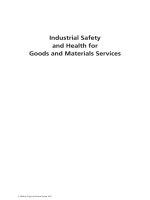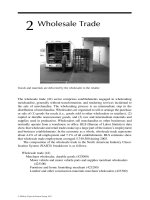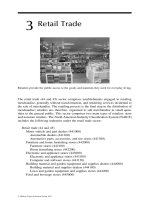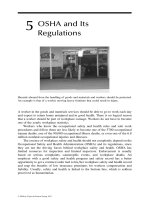Industrial Safety and Health for Goods and Materials Services - Chapter 19 pot
Bạn đang xem bản rút gọn của tài liệu. Xem và tải ngay bản đầy đủ của tài liệu tại đây (359 KB, 16 trang )
19
Material Handling
Material handling is a common task in each sector of industry. It is very common in
the industry sectors that store, receive, and sell goods and materials such as the retail,
wholesale, and warehousing sectors of the service industry.
The handling of all types of materials may manifest itself in the individual
worker’s effort to lift or move materials using large industrial cranes. No matter
which procedure is used, there are hazards and safety concerns that need to be
addressed. Almost every industrial sector has to address material handling issues,
especially workplaces moving materials in and products out on a set schedule. Yet
improper handling and storage of materials can result in grave injuries. Materials
may be anything from boxes, parts , equipment, steel beams, aircraft engines, or
manufactured homes.
The efficient handling and storage of materials is vital to the function of industry.
Material handling operations provide for the continuous flow of raw materials, parts,
and products throughout the workplace and assure that materials and products are
there when they are needed. Yet the improper handling and storage of materials can
cause serious injuries. In most industry sectors, around 20%–25% of all injuries are
caused by mat erial handling.
The proper and safe handling of a wide variety of materials must be do ne in
compliance with existing Occupational Safety and Health Administration (OSHA)
regulatory guidelines for the equipment used, the methods or procedures followed,
and the appropriate storage of each type of material.
The one constant in the goods and materials sectors is the lifting and handling of merchandise
of all types.
ß 2008 by Taylor & Francis Group, LLC.
The guidelines provided in this chapter should help prevent some of the material
handling accidents that are occurring in the goods and material sectors.
19.1 HAZARDS INVOLVED
Injuries faced by those performing material handling tasks may be something as
simple as overexertion, which results in sprains or strains, to simple cuts and
lacerations from sharp edges, or contact with moving parts on equipment. The
pinch (nip) points or shear weight of items being handled can result in bruises,
contusions, crushing, fractures, and amputations. The larger the objects, the larger
the equipment being used, and the faster the movement of materials, the greater the
risk for multiple injuries, suffocation, or, worst of all, death (Figure 19.1).
Many of the materials being handled by workers include hazardous chemicals
and have the potential for causing injuries and illnesses. Chemicals can cause
fires or explosion hazards and can result in burns or concussion injuries. Others
may present the potential for contact, ingestion, or inhalation exposures, which
may cause allergic reactions or toxic (poisonous) effects in workers, when such
materials are mishandled and=or spilled. It certainly seems safe to say that all
of these scenarios have transpired at one time or another to workers hand ling
hazardous chemicals.
Certainly, if some materials are too heavy and when lifting becomes repetitious,
the potential for overexertion will likely result in sprains and strains. But, materials
that are improperly stored or handled have the potential to shift due to their weight,
shape, or potential to flow. For example, sand being moved and stored at an unusual
FIGURE 19.1 Handling goods and materials is the primary hazard faced by workers.
ß 2008 by Taylor & Francis Group, LLC.
angle of repose may engulf a worker. This is particularly a problem around stock-
piles, surge bins, or excavations. When material shifts, it may physically strike a
worker, p inning him=her between a stationary object and the moving materials.
When using the wide variety of equipment available to move or handle the
different types of materials that exist in the workplace, the unevenness, unsecured
loads, and extreme weight of the loads being lifted or moved can cause equipment to
malfunction, collapse, or, at least, function erratically. The load can potentially fall
and strike a worker, swing into a worker, be caught under a piece of equipment, or
under a load, which cannot be controlled. This is why it is important to regularly
inspect and maintain equipment used for handling material. If a sling (wire rope,
steel alloy chain, or webb ed sling) fails, a crane boom collapses, or the brakes fail on
a forkl ift or other vehicle, the end results can be disastrous.
The use of equipment to handle materials is controlled by preestablished lifting
or load limits and restrictions on the supporting capacity of storage (shelving) units
which can never be exceeded if safety is a primary focus. It must be ensured that the
appropriate equipment is used for the job, and that it is proper ly used by the operator.
If an operator inadvertently contacts an electrical conductor, for example, electrocu-
tion is a real possibility.
Workers do not expect to be working under a load, have a load fall on them from
above, or to be run over by a piece of material-handling equipment. These hazards
are preventable using fundamental safety precautions.
The last hazard is derived from the myriad of chemicals handled or stored within
the workplace. Not only do they present the potential to cause physical harm (as
noted earlier when chemical containers shift, roll, or strike a worker injuring or
killing that worker), they also pose another type of hazard. They can potentially be
toxic (poisonous) or cause burns if mishandled, spilled, or not properly controlled.
Some chemicals may also creat e an explosion or fire.
As can be seen, the movement, stacking, and storage of materials pose
many hazards within the workplace. The philosophical approach to these hazards
must be that they are identifiable, preventable, and the accidents, that result in injuries,
illnesses, and deaths from improper material handling, can significantly be reduced.
19.2 SAFE HANDLING
The efficient handling and storing of materials are vital to industries. In addition
to raw materials, these operations provide a continuous flow of parts and
assemblies through the workplace and ensure that materials are available when
needed. Unfortunately, the improper handling and storing of materials often result
in serious injuries.
In addition to training and education, applying general safety principles—such as
proper work practices, equipment, and controls—can help reduce workplace accidents
involving the moving, handling, and storing of materials. Whether moving materials
manually or mechanically, employees should know and understand the potential haz-
ards associated with the task at hand and how to control their workplaces to minimize
the danger.
ß 2008 by Taylor & Francis Group, LLC.
Because numerous injuries can result from improperly handling and storing mater-
ials, workers should also be aware of accidents that may result from the unsafe or
improper handling of equipment as well as from improper work practices. In addition,
workers should be able to recognize the methods for eliminating or at least minimizing
the occurrence of such accidents. Employers and employees should examine their
workplaces to detect any unsafe or unhealthful conditions, practices, or equipment
and take corrective action.
Workers frequently cite the weight and bulkiness of objects that they lift as major
contributing factors to their injuries. In 1999, for example, more than 420,000 work-
place accidents resulted in back injuries. Bending, followed by twisting and turning,
were the more commonly cited movements that caused back injuries (Figure 19.2).
Other hazards include falling objects, improperly stacked materials, and various
types of equipment. Employees should be made aware of potential injuries when
manually moving materials, including the following:
.
Strains and sprains from lifting loads improperly or from carrying loads that are
either too large or too heavy
.
Fractures and bruises caused by being struck by materials or by being caught in
pinch points
.
Cuts and bruises caused by falling materials that have been improperly stored or by
incorrectly cutting ties or other securing devices
19.2.1 MANUAL HANDLING SAFETY
When moving materials manually, workers should attach handles or holders to loads.
In addition, workers should always wear appropriate personal protective equipment
FIGURE 19.2 Material handling tasks result in strain being placed on the back.
ß 2008 by Taylor & Francis Group, LLC.
and use proper lifting techniques. To prevent injury from oversize loads, workers
should seek help when the following conditions exist:
.
When a load is so bulky that employees cannot properly grasp or lift it
.
When employees cannot see around or over a load (Figure 19.3)
.
When employees cannot safely handle a load
Using the following personal protective equipment prevents needless injuries when
manually moving materials:
.
Hand and forearm protection, such as gloves, for loads with sharp or rough
edges
.
Eye protection
.
Steel-toed safety shoes or boots
.
Metal, fiber, or plastic metatarsal guards to protect the instep area from
impact or compression
Employees should use blocking materials to manage loads safely. Workers should
also be cautious when placing blocks under a raised load to ensure that the load is not
released before removing their hands from under the load. Blocking materials should
be large and strong enough to support the load safely. In addition to materials with
cracks, workers should not use materials with rounded corners, splintered pieces, or
dry rot for blocking.
FIGURE 19.3 The inability to see around a load creates a hazard.
ß 2008 by Taylor & Francis Group, LLC.
19.2.2 MECHANICAL HANDLING EQUIPMENT
Using mechanical equipment to move and store materials increases the potential
for employee injuries. Workers must be aware of both manual handling safety
concerns and safe equipment operating techniques. Employees should avoid over-
loading equipment when moving materials mechanically by choosing the equipment
based on the weight, size, and shape of the material being moved. All materials-
handling equipment have rated capacities that determine the maximum weight the
equipment can safely handle and the conditions under which it can handle that
weight. Employers must ensure that the equipment’s rated capacity is displayed on
each piece of equipment and is not exceeded except for load testing (Figure 19.4).
Although workers may be knowledgeable about powered equipment, they
should take precautions when stacking and storing material. When lifting items
with a powered industrial truck (forklift), workers must do the following:
.
Center the load on the forks as close to the mast as possible to minimize the
potential for the truck tipping or the load from falling.
.
Avoid overloading a lift truck because it impairs control and causes tipping
over.
.
Do not place extra weight on the rear of a counterbalanced forklift to allow
an overload.
.
Adjust the load to the lowest position when traveling.
.
Follow the forklift manuf acturer’s operational requirements.
.
Pile and cross-tier all stacked loads correctly when possible.
Chapter 20 provides more detailed information on the safe use of forklifts.
FIGURE 19.4 Care must be taken by operator to not overload stockpickers.
ß 2008 by Taylor & Francis Group, LLC.
19.2.3 SAFE STORAGE OF MATERIALS
Stored material s must not create a hazard for employees. Emplo yers should inform
workers of such factors as the material s’ height and weight, accessibilit y of the stored
materials, and the condit ion of the contai ners wher e the mat erials are being stored
when stack ing and piling materials. To prevent creat ing hazards when storing
materials, employers must do the follow ing:
.
Keep storage areas free from accum ulated materials that cau se tripping , fires,
or ex plosions, or that may contribut e to the harbor ing of rats and other pests.
.
Place stor ed mat erials inside buildings that a re under const ruction and a t
least 6 ft from hoist ways, or inside fl oor o penings and at least 10 ft away
from exterior walls.
.
Separate noncom pati ble material .
.
Equip employees who wor k on stored grain in silos, h oppers, or tanks, wi th
lifelines and safety harnes ses.
.
In addit ion, wor kers shoul d consi der placing bound material on racks, and
secure it by stacking, blocki ng, or interlock ing to prevent it from sliding,
falling, or collapsin g.
19.2.4 SAFE STACKING OF MATERIALS
Stacking mat erials can be dan gerous if wor kers do not foll ow safet y guidelines .
Falling materials and collapsin g loads can crush or pin wor kers, causi ng injuries or
death. To help prevent inju ries when stack ing mate rials, workers must do the
following:
.
Stack lum ber no more than 16 ft high if it is hand led manua lly, and no more
than 20 ft if using a forklift.
.
Remove all nails from used lumber before stack ing.
.
Stack and level lumber on solidly supported bracing.
.
Ensure that stacks are stable and self-suppo rting.
.
Do not store pipes and bars in racks that face main aisles to avoid creating a
hazard to passersby when removing supplies.
.
Stack bags and bundles in interlocking rows to keep them secure
(Figure 19.5 ).
.
Stack bagged material by stepping back the layers and cross-keying the
bags at least every 10 layers (to remove bags from the stack, start from the
top row first) .
During materials stacking activities, workers must also do the following:
.
Store baled paper and rags inside a building no closer than 18 in. to the
walls, partitions, or sprinkler heads.
.
Band boxed materials or secure them with cross-ties or shrink plastic fiber.
.
Stack drums, barrels, and kegs symmetrically.
ß 2008 by Taylor & Francis Group, LLC.
.
Block the bottom tiers of drums, barrels, and kegs to keep them from rolling
if stored on their sides.
.
Place planks, sheets of plywood dunnage, or pallets between each tier of
drums, barrels, and kegs to make a firm, flat, stacking surface when stacking
on end.
.
Check the bottom tier of drums, barrels, and kegs on each side to prevent
shifting in either direction when stacking two or more tiers high.
.
Stack and block poles as well as structural steel, bar stock, and other
cylindrical materials to prevent spreading or tilting unless they are in racks.
In addition, the following recommendations should be followed to make this easier
for workers:
.
Paint walls or posts with stripes to indicate maximum stacking heights for
quick reference.
.
Observe height limitations when stacking materials.
.
Consider the need for availability of the material.
.
Stack loose brick s no more than 7 ft in height. (When these stacks reach a
height of 4 ft, taper them back 2 in. for every foot of height above the 4 ft
level. When masonry blocks are stacked higher than 6 ft, taper the stacks
back one-half block for each tier above the 6 ft level.)
19.2.5 HOUSEKEEPING
The importance of preventing the type of accide nts that can be caused by
poor housekeeping practices is an integral part of good material handling practices.
FIGURE 19.5 Proper stacking of bags.
ß 2008 by Taylor & Francis Group, LLC.
The typical accidents that frequently result from inadequate housekeeping are as
follows:
.
Tripping over loose objects on floors, stairs, and platforms
.
Slipping on wet, greasy, or dirty floors
.
Bumping against projecting or misplaced materials
.
Puncturing or scratching hands or other parts of the body on protruding
nails, hooks, or rods
.
Injuries from falling objects
Employees tend to take housekeeping for granted and may sometimes be careless.
Housekeeping is the one area of accident prevention in which all employees (blue-
collar, white-collar, administrative, etc.) must share the responsibility. The emphasis
on housekeeping should be at
.
Work areas: Avoid unnecessary clutter (Figure 19.6).
.
Machines and equipment: Avoid crowding; provide racks or containers for
tools, jigs, and fixtures.
.
Aisles: Keep free of material, finished parts, and scrap.
.
Floors: Make sure they are vacuumed and scrubbed regularly; spills should
be cleaned up immediately.
.
Walls and ceilings: See to it that they are scrubbed and painted when
necessary; clothing and supplies should be hung on racks; clutter should
be confined to a bulletin board.
FIGURE 19.6 Poor housekeeping is a primary cause of accidents.
ß 2008 by Taylor & Francis Group, LLC.
.
Storage facilities: Follow appropriate storage procedures.
.
Employee facilities: Keep personal belongings in lockers; washrooms
should be cleaned regularly.
Housekeeping inspections should occur regularly. It should be easy to recognize the
benefits of good houseke eping since it
.
Reduces operating costs: Once a housekeeping system has been estab-
lished, less time and effort are required to keep the work area clean.
.
Increases production: Delays and interference from excess materials, loose
tools, etc., are avoide d.
.
Improves production control: Material and parts do not get lost or mixed up.
.
Conserves materials and parts: Unused materials are easily and quickly
removed to the proper place.
.
Saves production time: There is no need to search for tools, parts, etc.
.
Lowers accident rates since open aisles permit faster traffic with fewer
collisions; clean floors mean less slipping, tripping, and falling; reduction
of object hazards results in fewer injuries.
.
Reduces fire hazards: Fires result from, or are spread by, poor housekeeping
conditions.
Some common sense tips for good housekeeping are as follows:
.
Give your immediate work area a good cleaning at the end of each day.
Sweep up rubbish and put tools away.
.
Dispose of combustible rubbish in fire-resistant receptacles.
.
Dispose of oily rags in closed metal containers. Maintain regular disposal.
.
Clean oily deposits from walls, ceilings, exhaust ducts, and mechanical
equipment periodically.
.
Remove combustible lint and dust from ledges, beams, and equipment as it
accumulates.
.
Remove oily metal chips and rubbish to outside storage locations on
schedule.
.
Keep aisles and passageways clear of stock and other obstr uctions at all
times.
.
Do not block valves, hose stations, fire extinguishers, or fire exits.
.
Keep packing material in metal-lined bins with self-closing covers.
.
Follow the clean-out schedules for electric motors, switch enclosures,
contacts, etc.
.
Keep solvents, thinners, etc., in approved safety containers .
.
Avoid drippings—clean up spills promptly.
.
Keep spray residues in covered containers and remove at the end of each
day.
.
Limit flammable liquids, cement, paint, etc., to only one day’s supply at the
working area.
.
Empty drip pans and replace absorbent compounds frequently.
ß 2008 by Taylor & Francis Group, LLC.
.
Avoid overlubrication.
.
Keep a minimum supply of lubricants in the work area.
19.3 MATERIAL-HANDLING EQUIPMENT
Probably few facets of safety and health have such a wide variety of equipment with
which to be concerned as material handling. Some equipment are as simple as a
handcart or dolly and some as complex as industrial robots. Examples of nonpo-
wered equipment are dollies, hand trucks, carts, dockboards, and ramps.
A mechanical advantage can be enhanced by using powered equipment for
smaller items not requiring industrial hoists, conveyors, forklifts, cranes, or heavy-
duty trucks. Some of these types of available handling devices are operated by
hydraulic, compressed air, or electrical energy.
To reduce the number of accidents associated with workplace equipment,
employers must train employees in the proper use and limitations of the equipment
they operate. In addition to powered industrial trucks, this includes knowing how to
safely and effectively use equipm ent such as conveyors, cranes, and slings. The
following are some commonly used material-handling equipment.
19.3.1 CONVEYORS
When using conveyors, workers may get their hands caught in nip points where the
conveyor medium runs near the frame or over support members or rollers. Workers
also may be struck by material falling off the conveyor, or they may get caught in the
conveyor and drawn into the conveyor path as a result (Figure 19.7). To prevent or
FIGURE 19.7 Conveyors are used to decrease manual handling.
ß 2008 by Taylor & Francis Group, LLC.
reduce the severity of an injury, employers must take the following precautions to
protect workers:
.
Install an emergency button or pull cord designed to stop the conveyor at
the employee’s workstation.
.
Install emergency stop cables that extend the entire length of continuously
accessible conveyor belts so that the cables can be accessed from any
location along the conveyor.
.
Design the emergency stop switch so that it must be reset before the
conveyor can be restarted.
.
Ensure that appropriate personnel inspect the conveyor and clear the stop-
page before restarting a conveyo r that has stopped due to an overload.
.
Prohibit employees from riding on a materials-handling conveyor.
.
Provide guards where conveyors pass over work areas or aisles to keep
employees from being struck by falling material. (If the crossover is low
enough for workers to run into it, mark the guard with a warning sign or
paint it a bright color to protect employees.)
.
Cover screw conveyors completely except at loading and discharging
points. (At those points, guards must protect employees against contacting
the moving screw. The guards are movable, and they must be interlocked to
prevent conveyor movement when the guards are not in place.)
19.3.2 CRANES
Employers must permit only thoroughly trained and competent workers to operate
cranes. Operators should know what they are lifting and what it weighs. For
example, the rated capacity of mobile cranes varie s with the length of the boom
and the boom radius. When a crane has a telescoping boom, a load may be safe to lift
at a short boom length or a short boom radius, but may overload the crane when the
boom is extended and the radius increases. To reduce the severity of an injury,
employers must take the following precautions:
.
Equip all cranes that have adjustable booms with boom angle indicators.
.
Provide cranes with telescoping booms with some means to determine
boom lengths unles s the load rating is independent of the boom length.
.
Post load rating charts in the cab of cab-operated cranes. (All cranes do not
have uniform capacities for the same boom length and radius in all direc-
tions around the chassis of the vehicle.)
.
Require that workers always check the crane’s load chart to ensure that the
crane will not be overloaded by operating conditions.
.
Instruct workers to plan lifts before starting them to ensure that they are safe.
.
Tell workers to take additional precautions and exercise extra care when
operating around power lines.
.
Teach workers that outriggers on mobile cranes must rest on firm ground,
on timbers, or be sufficiently cribbed to spread the weight of the crane and
ß 2008 by Taylor & Francis Group, LLC.
the load over a large e nough area. (Some mobile cranes cannot operat e wi th
outriggers in the trave ling position .)
.
Direct workers to always ke ep hoisting chains and ropes free of kinks or
twists and ne ver wra pped around a load.
.
Train wor kers to atta ch loads to the load hook by slings, fixtures, and other
devices that have the c apacity to suppor t the load on the hook.
.
Instruct wor kers to pad sharp edges of loads to prevent cutting slings.
.
Teach wor kers to maintai n proper sling angles so that slings are not over-
loaded.
.
Ensure that all cranes are inspe cted freque ntly by author ized person s, the
methods of inspe cting the crane, an d what can render the crane unserv ice-
able. Crane activity , the severity of use, and env ironment al condition s
should deter mine inspec tion schedules.
Ensure that the critical parts of a crane — such as crane operating mechanism s, hooks,
air, or hyd raulic system compo nents and other load-carryi ng components — are
inspected dail y for any mal adjustm ent, deteriorat ion, leakage , deformati on, or
other damag e.
19.3.3 SLINGS
Employers must designate a compe tent person to co nduct inspe ctions of slings
before and durin g use, especiall y when servi ce condit ions warrant. In addition,
workers must observe the following precaut ions when wor king with slings:
.
Remove immediatel y damaged or defect ive slings from servic e.
.
Do not short en slings with knots or bolt s or other makes hift device s.
.
Do not kink sling legs.
.
Do not load slings beyond their rated capaci ty.
.
Keep suspen ded loads clear of all obstr uctions.
.
Remain clear of loads about to b e lifted and suspen ded.
.
Do not enga ge in shock loadi ng.
.
Avoid sudden crane acceler ation a nd decele ration when movi ng suspen ded
loads.
19.3.4 FORKLIFTS
Workers who handle and stor e materials often use fork trucks, plat form lift trucks,
motorized hand trucks, and other specialized industrial trucks powered by electrical
motors or internal combustion engines. Employers must make these workers aware
of the safety requirements pertaining to the design, maintenance, and use of these
trucks. For more details on these requireme nts refer Chapter 20.
19.4 TRAINING AND EDUCATION
OSHA recommends that employers establish a formal training program to teach
workers how to recognize and avoid materials-handling hazards. Instructo rs shoul d
ß 2008 by Taylor & Francis Group, LLC.
be well versed in safety engineering and materials handling and storing. The training
should reduce workplace hazards by emphasizing the following factors:
.
Dangers of lifting without proper training
.
Avoidance of unnecessary physical stress and strain
.
Awareness of what a worker can comfortably handle without undue strain
.
Proper use of equipment
.
Recognition of potential hazards and how to prevent or correct them
The prevention of some injuries receives special emphasis. Because of the high
incidence of back injuries, both supervisors and employees should demonstrate and
practice safe manual lifting techniques. Training programs on proper lifting tech-
niques should cover the following topics:
.
Health risks of improper lifting, citing organizational case histories, versus
the benefits of proper lifting
.
Basic anatomy of the spine, muscles, and joints of the trunk, and the
contributions of intra-abdominal pressure while lifting
.
Body strengths and weaknesses—determining one’s own lifting capacity
.
Physical factors that might contribute to an accide nt and how to avoid the
unexpected
.
Safe postures for lifting and timing for smooth, easy lifting
.
Aids such as stages, platforms, or steps, trestles, shoulder pads, handles,
and wheels
.
Body responses—warning signals—to be aware of when lifting
To have an effective safety and health program coveri ng materials handling and
storing, managers must actively participate in its develo pment. First line supervisors
must be convinced of the importance of controlling hazards associated with materials
handling and storing and must be accountable for employee training. An ongoing
safety and health management system can motivate employees to continue using
necessary protectiv e gear and observing proper job procedures. Instituting such a
program, along with providing the correct materials-handling equipment, can
enhance worker safety and health in the area of materials handling and storing.
19.5 MATERIAL HANDLING REGULATIONS
Specific regulatio ns, applicable to material handling within General Industry
(29 CFR 1910) Standards are as follows:
Subpart H—Hazardous materials
1910.101—Compressed gases
1910.102—Acetylene
1910.103—Hydrogen
1910.104—Oxygen
ß 2008 by Taylor & Francis Group, LLC.
1910.105—Nitrous oxide
1910.106—Flammable and combustible liquids
1910.107—Storage and handling of anhydrous ammonia
1910.109—Explosives and blasting agents
1910.110—Storage and handling of liquefied petroleum gases
Subpart J—General environmental controls
1910.144—Safety color code for marking physical hazards
1910.145—Specifications for accident prevention tags
Subpart N—Material handling and storage
1910.176—Handling materials—general
1910.178—Powered industrial trucks
1910.179—Overhead and gantry crane
1910.180—Crawler, locomotion, and truck cranes
1910.181—Derricks
1910.183—Helicopters
1910.184—Slings
Subpart Q—Welding, cutting, and brazing
1910.253—Oxygen-fuel gas welding and cutting
Although other 29 CFR 1910 regulations are tangential, related to material handling,
and apply to most workplaces, the previous list includes the ones most applicable to
material handling.
19.6 SUMMARY
Employers can reduce injuries resulting form handling and storing material by using
some basic safety procedures such as adopting sound ergonomic practices, taking
general fire safety precautions, and keepin g aisles and passageways clear.
ß 2008 by Taylor & Francis Group, LLC.
ß 2008 by Taylor & Francis Group, LLC.
